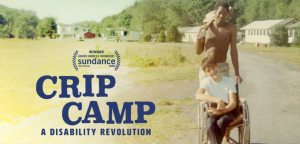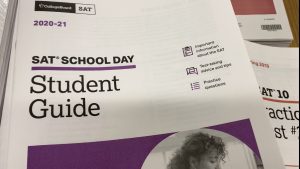Students express their perspectives on possible return to full time in-person learning
Ms. Nanin’s Spanish 2 class works on assignmnets.
March 23, 2021
With Eagle County’s recent transition to yellow on the COVID tracker and the majority of at-risk community members receiving the vaccine, Eagle Valley High School is looking at returning to full time, in-person learning four days a week. Public Health, Eagle County Schools, teachers and staff, parents, and students’ inputs are all being considered. The majority of the student population of Eagle Valley High School doesn’t really have a voice when it comes to this possible schedule change, but they do have opinions.
Students will be most directly impacted by this upcoming decision. Student athletes, student workers, students taking care of younger siblings, and Bilingual Instructional Aides will all be impacted differently.
On asynchronous days, students are assigned work and expected to get it done on their own time. This has proved difficult for some students.
“Being able to work from home can be a distraction,” Sydney Webster ‘24 reflects. “I get bored easily and just end up watching TikToks a lot.”
These students find that having to complete work on their own can be challenging, and they are unproductive.
“What I don’t like is that on the asynchronous days you get the work, and you teach it to yourself,” explains Victoria Aragon ‘22, “I see it to be more beneficial to be in school every single day just because I can interact with my teachers and peers and learn more from them rather than being so independent in my education.”
There is hope that a return to in-person learning fours days a week would offer a more productive and interactive education.
“I think we get more out of our education if we do that, and I think that we should have a normal school schedule,” Justin Vargas ‘23 explains in regards to four day school weeks. “I think that my education comes first.”
Many students have been separated from their friends because of the A day and B day aspect of the hybrid model. Some students like Hannah Rippstein ‘22 have hardly any friends on their synchronous learning day.
“I don’t like that I’m not with my friends because all my friends are on A days,” Rippstein explains.
Although most students are mourning their lack of social interaction, no one is feeling it more than the seniors.
Approaching graduation, Tyler Morrison ‘21 is missing his fellow classmates.
“I have gone to school with 90% of the seniors since I was five years old. It would be nice to have a last hoorah with all of these people that I don’t get to see everyday anymore,” Morrison says.
An in-person learning four days a week schedule would enable seniors to reunite with their class for the last months or so of school.
“I think that for the seniors and juniors it would be awesome, like being able to see everybody all the time and getting that reunification,” Morrison explains. “It would foster relationships and build up the community, so I do hope that we can go back.”
Despite the disadvantages, students have been learning under the hybrid model for the majority of the school year and recognize that has provided students with different opportunities. For example, students who appreciate that extra time that come from the breaks between classes in the flex mod schedule.
“I wish we could keep the schedule. Having the long breaks is really nice to get stuff done,” Rippstein says. “I feel like students are really benefiting from time in between classes to just chill and not feel like it’s back to back seven hours a day.”
The breaks create an opportunity to do work during the day and mentally refresh.
“I think they are very helpful just because of how packed the schedule is, also having that mental break.”
The hybrid model has also enabled students to work on their asynchronous days.
“The hybrid model has opened up more opportunities for me to work,” Justin Vargas ’23, who works at Bravo Vail, reflects.
Because students can do assignments on their own time on asynchronous days, they can also schedule more hours at their jobs.
Student athletes have also seen benefits from the the hybrid schedule. They are able to participate in their sports like normal while missing less school than in the normal schedule.
“The hybrid model during football was really nice,” Tyler Morrison explains, who plays football and lacrosse. “It was nice to come in and go for rehab and not have to worry about missing class.”
While the four day a week in-person schedule might be great in theory, in practice it could put a strain on lots of students’ schedules. Students and families have adjusted to make the hybrid schedule work this year. Some students take care of their siblings on the asynchronous days and being in school full time will get rid of this option for lots of parents and families. Grace Schultz ’23 takes care of her two younger siblings on asynchronous days.
“It makes me feel just a little bit uneasy just because I know that my family is counting on me for that day that I watch my siblings,” Schultz explains. This new schedule, if implemented, would force Grace’s mom to quit her job. “I think that they shouldn’t try to implement that this year.”
The Bilingual Instructional Aide program has adjusted this year to work with the hybrid schedule. This program enables bilingual students go into classrooms to translate and help students who are learning English. The program would need to transform significantly to work with student schedules in a full time in-person learning model .
“It has had a very big impact on me because I have been able to meet students I normally would not have met and it has allowed me to give back to my community,” Aragon explains. Returning to a four day in-person learning schedule would prohibit her from continuing to be a Bilingual IA because, “I do take a lot of classes and if I do have any breaks I am busy with all of my outside activities.” She and many other Bilingual IAs are only able to participate in this program because of the extra time the hybrid model has provided her.
Other students wonder if switching is worth it at this point in the school year.
“Switching to four days for the rest of the school year, which isn’t even that long, we only have like a quarter left, would just mess up a lot of kids,” Webster points out.
Students have different opinions when it comes to the possible return to four days a week, in-person learning. Each student interviewed recognizes pros and cons of each model. No matter what the decision is, students just want to have a voice and they want to be consulted about it.
“I hope that the school district considers how their choice will impact students’ lives,” Aragon emphasizes.






